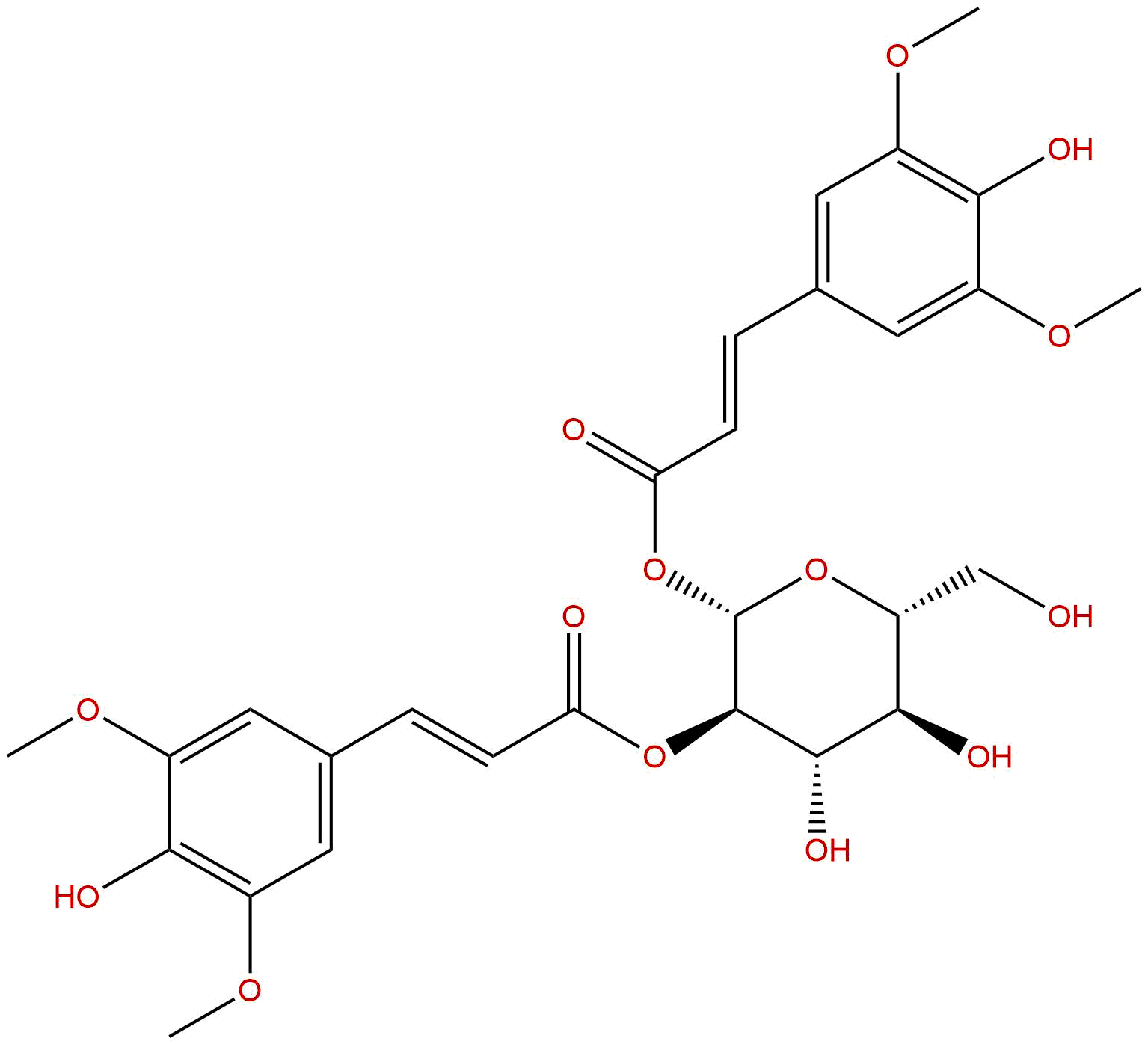1,2-DisinapoylglucoseCAS# 91095-79-3 |

Quality Control & MSDS
Package In Stock
Number of papers citing our products

| Cas No. | 91095-79-3 | SDF | Download SDF |
| PubChem ID | N/A | Appearance | Powder |
| Formula | C28H32O14 | M.Wt | 592.55 |
| Type of Compound | N/A | Storage | Desiccate at -20°C |
| Solubility | Soluble in Chloroform,Dichloromethane,Ethyl Acetate,DMSO,Acetone,etc. | ||
| General tips | For obtaining a higher solubility , please warm the tube at 37 ℃ and shake it in the ultrasonic bath for a while.Stock solution can be stored below -20℃ for several months. We recommend that you prepare and use the solution on the same day. However, if the test schedule requires, the stock solutions can be prepared in advance, and the stock solution must be sealed and stored below -20℃. In general, the stock solution can be kept for several months. Before use, we recommend that you leave the vial at room temperature for at least an hour before opening it. |
||
| About Packaging | 1. The packaging of the product may be reversed during transportation, cause the high purity compounds to adhere to the neck or cap of the vial.Take the vail out of its packaging and shake gently until the compounds fall to the bottom of the vial. 2. For liquid products, please centrifuge at 500xg to gather the liquid to the bottom of the vial. 3. Try to avoid loss or contamination during the experiment. |
||
| Shipping Condition | Packaging according to customer requirements(5mg, 10mg, 20mg and more). Ship via FedEx, DHL, UPS, EMS or other couriers with RT, or blue ice upon request. | ||

1,2-Disinapoylglucose Dilution Calculator

1,2-Disinapoylglucose Molarity Calculator
| 1 mg | 5 mg | 10 mg | 20 mg | 25 mg | |
| 1 mM | 1.6876 mL | 8.4381 mL | 16.8762 mL | 33.7524 mL | 42.1905 mL |
| 5 mM | 0.3375 mL | 1.6876 mL | 3.3752 mL | 6.7505 mL | 8.4381 mL |
| 10 mM | 0.1688 mL | 0.8438 mL | 1.6876 mL | 3.3752 mL | 4.2191 mL |
| 50 mM | 0.0338 mL | 0.1688 mL | 0.3375 mL | 0.675 mL | 0.8438 mL |
| 100 mM | 0.0169 mL | 0.0844 mL | 0.1688 mL | 0.3375 mL | 0.4219 mL |
| * Note: If you are in the process of experiment, it's necessary to make the dilution ratios of the samples. The dilution data above is only for reference. Normally, it's can get a better solubility within lower of Concentrations. | |||||

Calcutta University

University of Minnesota

University of Maryland School of Medicine

University of Illinois at Chicago

The Ohio State University

University of Zurich

Harvard University

Colorado State University

Auburn University

Yale University

Worcester Polytechnic Institute

Washington State University

Stanford University

University of Leipzig

Universidade da Beira Interior

The Institute of Cancer Research

Heidelberg University

University of Amsterdam

University of Auckland

TsingHua University

The University of Michigan

Miami University

DRURY University

Jilin University

Fudan University

Wuhan University

Sun Yat-sen University

Universite de Paris

Deemed University

Auckland University

The University of Tokyo

Korea University
- Caffeic acid 4-O-glucopyranoside
Catalog No.:BCX0984
CAS No.:17093-82-2
- Celosin L
Catalog No.:BCX0983
CAS No.:1950581-97-1
- Dosulepin impurity A
Catalog No.:BCX0982
CAS No.:42046-35-5
- Oseltamivir impurity A
Catalog No.:BCX0981
CAS No.:1364932-19-3
- Testosterone enantate impurity H
Catalog No.:BCX0980
CAS No.:162890-98-4
- Celosin H
Catalog No.:BCX0979
CAS No.:1623405-28-6
- 1,2-Disinapoylgentiobiose
Catalog No.:BCX0978
CAS No.:195006-75-8
- Carpaine
Catalog No.:BCX0977
CAS No.:3463-92-1
- Hericene C
Catalog No.:BCX0976
CAS No.:157207-56-2
- Hericenone C
Catalog No.:BCX0975
CAS No.:137592-03-1
- Hericenone D
Catalog No.:BCX0974
CAS No.:137592-04-2
- 2'-O-Methylisomucronulatol
Catalog No.:BCX0973
CAS No.:2243403-57-6
- Notoginsenoside R3
Catalog No.:BCX0986
CAS No.:87741-76-2
- Antheraxanthin
Catalog No.:BCX0987
CAS No.:640-03-9
- Violaxanthin
Catalog No.:BCX0988
CAS No.:126-29-4
- 5-Methoxyisosakuranin
Catalog No.:BCX0989
CAS No.:59942-61-9
- (9Z,11E)-13-Oxo-9,11-octadecadienoic Acid
Catalog No.:BCX0990
CAS No.:54739-30-9
- Forbesione
Catalog No.:BCX0991
CAS No.:180961-63-1
- S-Isogambogic acid
Catalog No.:BCX0992
CAS No.:942623-57-6
- 1,3-Disinapoylglucose
Catalog No.:BCX0993
CAS No.:1423128-15-7
- Maltodecaose
Catalog No.:BCX0994
CAS No.:6082-21-9
- Maltononaose
Catalog No.:BCX0995
CAS No.:6471-60-9
- Hericene D
Catalog No.:BCX0996
CAS No.:1343477-87-1
- Neopuerarin B
Catalog No.:BCX0997
CAS No.:1150314-39-8
Genetic engineering of Arabidopsis to overproduce disinapoyl esters, potential lignin modification molecules.[Pubmed:28239412]
Biotechnol Biofuels. 2017 Feb 17;10:40.
BACKGROUND: Monolignol-like molecules can be integrated into lignin along with conventional monolignol units, and it has been shown that the incorporation of non-canonical subunits can be used to generate hydrolysable lignin by introduction of ester linkages into the polymer and that this type of lignin is more easily removable. Disinapoyl esters (DSEs), which to some degree resemble the monolignol sinapyl alcohol, may be promising lignin modifying units for this purpose. As a first step toward determining whether this goal is achievable, we manipulated metabolic flux in Arabidopsis to increase the amounts of DSEs by overexpressing sinapoylglucose:sinapoylglucose sinapoyltransferase (SST) which produces two main DSEs, 1,2-Disinapoylglucose, and another compound we identify in this report as 3,4-disinapoyl-fructopyranose. RESULTS: We succeeded in overproducing DSEs by introducing an SST-overexpression construct into the sinapoylglucose accumulator1 (sng1-6) mutant (SST-OE sng1-6) which lacks several of the enzymes that would otherwise compete for the SST substrate, sinapoyglucose. Introduction of cinnamyl alcohol dehydrogenase-c (cad-c) and cad-d mutations into the SST-OE sng1-6 line further increased DSEs. Surprisingly, a reduced epidermal fluorescence (ref) phenotype was observed when SST-OE sng1-6 plants were evaluated under UV light, which appears to have been induced by the sequestration of DSEs into subvacuolar compartments. Although we successfully upregulated the accumulation of the target DSEs, we did not find any evidence showing the integration of DSEs into the cell wall. CONCLUSIONS: Our results suggest that although phenylpropanoid metabolic engineering is possible, a deeper understanding of sequestration and transport mechanisms will be necessary for successful lignin engineering through this route.


